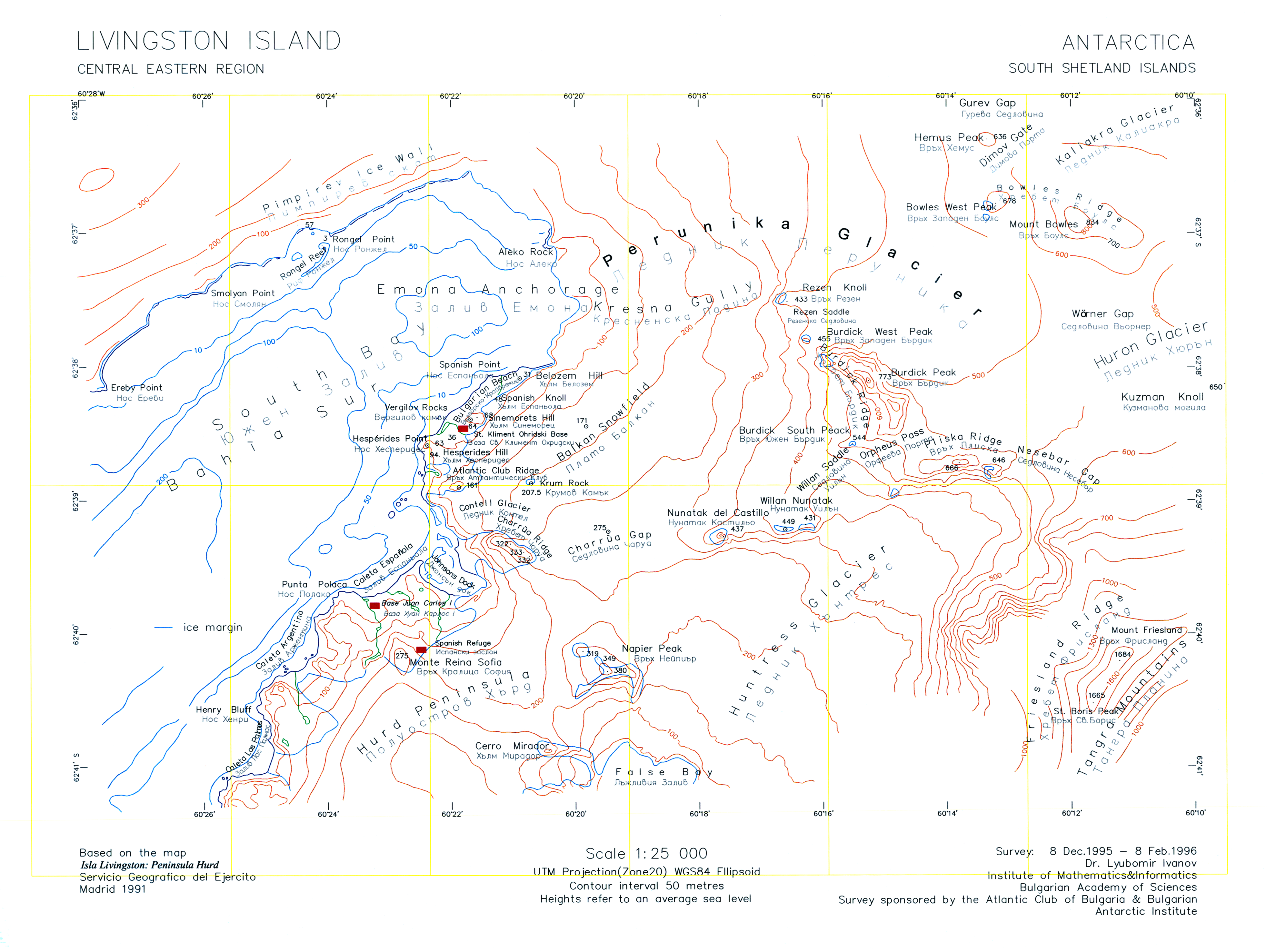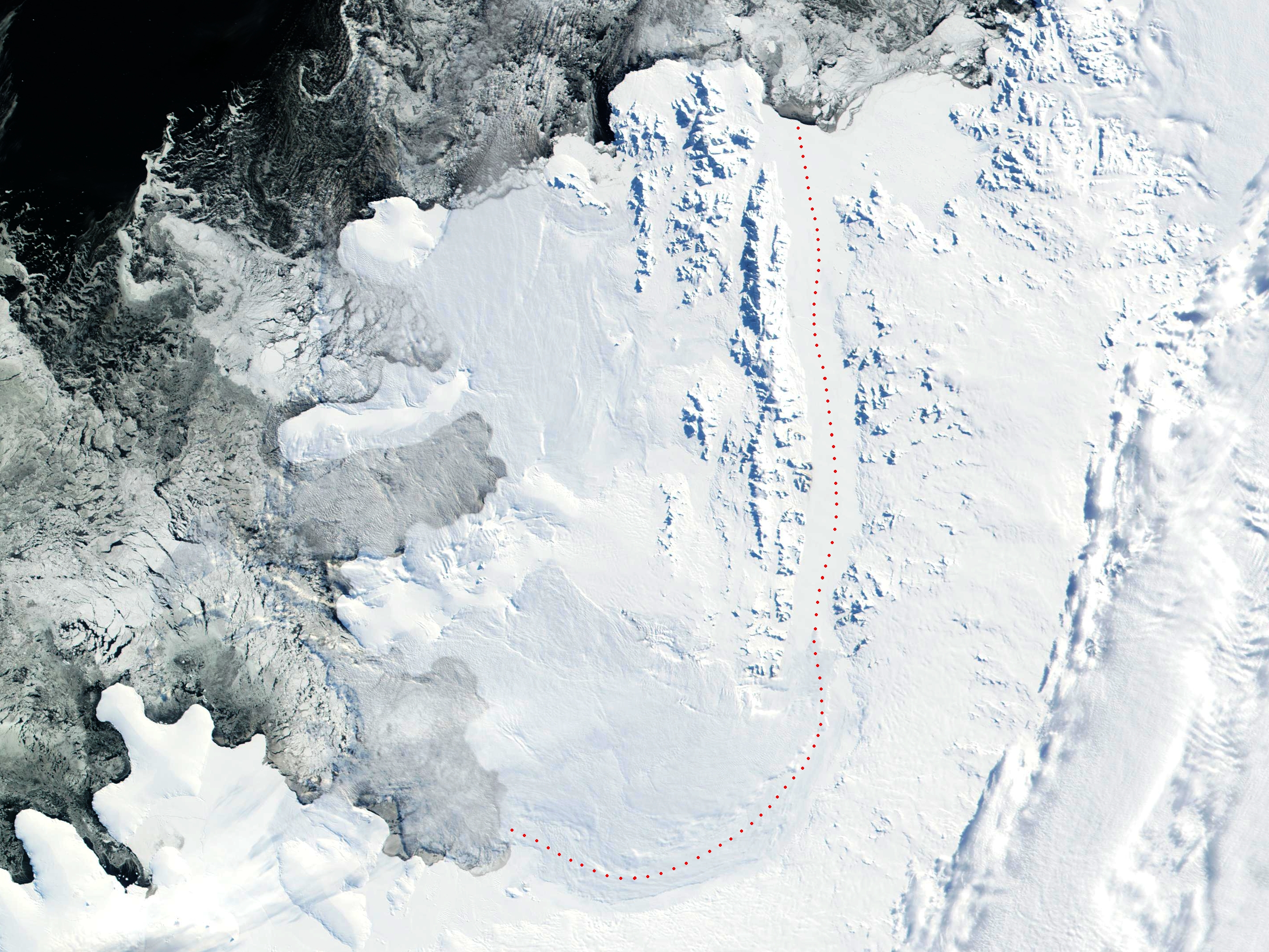|
Pimpirev Ice Wall
Pimpirev Ice Wall () is the rectilinear ice slope running parallel to and some 100 m inland from the northwest coast of Emona Harbour in Livingston Island, Antarctica. Approx. 50 m high, extending from the north corner of Emona Harbour 3,700 m in west-southwest direction. Named for Christo Pimpirev, leader of the Bulgarian Antarctic campaigns during the 1993/94, 1994/95, 1995/96, and subsequent seasons, who also conducted geological field work on Alexander Island during the summer of 1987/88. Maps * L.L. Ivanov. Livingston Island: Central-Eastern Region. Scale 1:25000 topographic map. Sofia: Antarctic Place-names Commission of Bulgaria, 1996. * L.L. Ivanov et al. Antarctica: Livingston Island and Greenwich Island, South Shetland Islands. Scale 1:100000 topographic map. Sofia: Antarctic Place-names Commission of Bulgaria, 2005. * L.L. IvanovAntarctica: Livingston Island and Greenwich, Robert, Snow and Smith Islands Scale 1:120000 topographic map. Troyan: Manfred Wörner Founda ... [...More Info...] [...Related Items...] OR: [Wikipedia] [Google] [Baidu] |
Emona Anchorage
Emona Anchorage (, ) is a roughly square embayment, the internal part of South Bay, Livingston Island in the South Shetland Islands, Antarctica used as an anchorage for ships visiting the Bulgarian base St. Kliment Ohridski. Emona is the name of a village and, in the version of Emine, a nearby cape on the Bulgarian Black Sea Coast. Location The feature is centred at . Details Entered between Hespérides Point and Smolyan Point, the bay is over 100 m deep at its central portion northwest by north of Spanish Point. Northeast of Smolyan Point, a nameless 710 m wide cove is indenting for 250 m behind Rongel Reef, with a shoal east of that cape, and a small awash islet 550 m due northeast of it. Rongel Point forms the east-northeast side of that cove's entrance. The remaining northwest coast of Emona Anchorage is, with several minor disruptions, a narrow beach under the ice-cap cliff, with Pimpirev Ice Wall, an ice form in Pimpirev Glacier running parallelly some 100 m inl ... [...More Info...] [...Related Items...] OR: [Wikipedia] [Google] [Baidu] |
Livingston Island
Livingston Island (Russian name ''Smolensk'', ) is an Antarctic island in the Southern Ocean, part of the South Shetland Islands, South Shetlands Archipelago, a group of List of Antarctic and subantarctic islands, Antarctic islands north of the Antarctic Peninsula. It was the first land discovered south of 60° south latitude in 1819, a historic event that marked the end of a centuries-long pursuit of the mythical Terra Australis, ''Terra Australis Incognita'' and the beginning of the exploration and utilization of real Antarctica. The name Livingston, although of unknown derivation, has been well established in international usage since the early 1820s. Geography Livingston Island is situated in West Antarctica, northwest of Cape Roquemaurel on the Antarctic mainland, south-southeast of Cape Horn in South America, southeast of the Diego Ramírez Islands (the southernmost land of South America), due south of the Falkland Islands, southwest of South Georgia Islands, and fr ... [...More Info...] [...Related Items...] OR: [Wikipedia] [Google] [Baidu] |
Antarctica
Antarctica () is Earth's southernmost and least-populated continent. Situated almost entirely south of the Antarctic Circle and surrounded by the Southern Ocean (also known as the Antarctic Ocean), it contains the geographic South Pole. Antarctica is the fifth-largest continent, being about 40% larger than Europe, and has an area of . Most of Antarctica is covered by the Antarctic ice sheet, with an average thickness of . Antarctica is, on average, the coldest, driest, and windiest of the continents, and it has the highest average elevation. It is mainly a polar desert, with annual Climate of Antarctica#Precipitation, precipitation of over along the coast and far less inland. About 70% of the world's freshwater reserves are frozen in Antarctica, which, if melted, would raise global sea levels by almost . Antarctica holds the record for the Lowest temperature recorded on Earth, lowest measured temperature on Earth, . The coastal regions can reach temperatures over in the ... [...More Info...] [...Related Items...] OR: [Wikipedia] [Google] [Baidu] |
Christo Pimpirev
Christo Pimpirev () is a Bulgarian scientist (geologist) and polar explorer. Academic career He was born on Friday, 13 February 1953 in Sofia, Bulgaria. After graduating from Sofia University with a master's degree in geology in 1978 and getting his PhD in 1986, he became an associate professor till 2004 and a full-time professor in 2005 in Sofia University “St. Kliment Ohridski”. In 2017, he defended his dissertation on "Stratigraphy and Geological Evolution of Livingston Island during the Cretaceous Period" and acquired the degree of Doctor of Science. Prof. Pimpirev is a doyen of the Bulgarian Antarctic Program, He took part in the first Bulgarian Antarctic Expedition during the 1987/88 austral summer, and has been the leader of the annual Bulgarian scientific campaigns in Antarctica from 1993 until now. He became the founding father of the Bulgarian Antarctic Institute and its director since 1993 up to now. He is also a director of the National Center for Polar Research ... [...More Info...] [...Related Items...] OR: [Wikipedia] [Google] [Baidu] |
Bulgaria
Bulgaria, officially the Republic of Bulgaria, is a country in Southeast Europe. It is situated on the eastern portion of the Balkans directly south of the Danube river and west of the Black Sea. Bulgaria is bordered by Greece and Turkey to the south, Serbia and North Macedonia to the west, and Romania to the north. It covers a territory of and is the tenth largest within the European Union and the List of European countries by area, sixteenth-largest country in Europe by area. Sofia is the nation's capital and List of cities and towns in Bulgaria, largest city; other major cities include Burgas, Plovdiv, and Varna, Bulgaria, Varna. One of the earliest societies in the lands of modern-day Bulgaria was the Karanovo culture (6,500 BC). In the 6th to 3rd century BC, the region was a battleground for ancient Thracians, Persians, Celts and Ancient Macedonians, Macedonians; stability came when the Roman Empire conquered the region in AD 45. After the Roman state splintered, trib ... [...More Info...] [...Related Items...] OR: [Wikipedia] [Google] [Baidu] |
Alexander Island
Alexander Island, which is also known as Alexander I Island, Alexander I Land, Alexander Land, Alexander I Archipelago, and Zemlja Alexandra I, is the largest island of Antarctica. It lies in the Bellingshausen Sea west of Palmer Land, Antarctic Peninsula from which it is separated by Marguerite Bay and George VI Sound. The George VI Ice Shelf entirely fills George VI Sound and connects Alexander Island to Palmer Land. The island partly surrounds Wilkins Sound, which lies to its west.Stewart, J. (2011) ''Antarctic An Encyclopedia'' McFarland & Company Inc, New York. 1776 pp. . Alexander Island is about long in a north–south direction, wide in the north, and wide in the south. Alexander Island is the second-largest uninhabited island in the world, after Devon Island. History Alexander Island was discovered on January 28, 1821, by a Russian expedition under Fabian Gottlieb von Bellingshausen, who named it Alexander I Land for the reigning Tsar Alexander I of Russia. What, in ... [...More Info...] [...Related Items...] OR: [Wikipedia] [Google] [Baidu] |
Topographic Map
In modern mapping, a topographic map or topographic sheet is a type of map characterized by large- scale detail and quantitative representation of relief features, usually using contour lines (connecting points of equal elevation), but historically using a variety of methods. Traditional definitions require a topographic map to show both natural and artificial features. A topographic survey is typically based upon a systematic observation and published as a map series, made up of two or more map sheets that combine to form the whole map. A topographic map series uses a common specification that includes the range of cartographic symbols employed, as well as a standard geodetic framework that defines the map projection, coordinate system, ellipsoid and geodetic datum. Official topographic maps also adopt a national grid referencing system. Natural Resources Canada provides this description of topographic maps: Other authors define topographic maps by contrasting them with ... [...More Info...] [...Related Items...] OR: [Wikipedia] [Google] [Baidu] |
Antarctic Place-names Commission
The Antarctic Place-names Commission was established by the Bulgarian Antarctic Institute in 1994, and since 2001 has been a body affiliated with the Ministry of Foreign Affairs (Bulgaria), Ministry of Foreign Affairs of Bulgaria. The Commission approves Bulgarian place names in Antarctica, which are formally given by the List of Presidents of Bulgaria, President of the Republic according to the Constitution of Bulgaria, Bulgarian Constitution (Art. 98) and the established international practice. Bulgarian names in Antarctica Geographical names in Antarctica reflect the history and practice of Antarctic exploration. The nations involved in Antarctic research give new names to nameless geographical features for the purposes of orientation, logistics, and international scientific cooperation. As of 2023, there are some 20,125 named Antarctic geographical features, including 1,606 features with names given by Bulgaria. [...More Info...] [...Related Items...] OR: [Wikipedia] [Google] [Baidu] |







